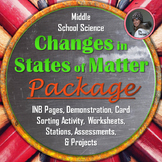Changes in States of Matter Interactive Notebook Pages
- PDF
What educators are saying
Also included in
- Here's your changes in states of matter unit for your middle school science classroom! Melting, freezing, vaporization, condensation, and sublimation are the phase changes covered in this bundle. You will save yourself a ton of planning time while presenting your students with an interesting, cohesiPrice $30.00Original Price $41.75Save $11.75
Description
In this resource there are two different Interactive Notebook pages. The first page has Part One of the notes which includes an overview of changes in states of matter along with melting and freezing. The second page has Part Two of the notes which goes over vaporization, condensation, and sublimation.
In the overview, the notes cover what causes the changes in states of matter. For each change in state the notes go over what the change is, how it occurs (gaining or losing energy), an example, and a drawing of the particles before and after the change.
You can read the notes aloud and introduce the topic through lecture while students listen and fill in their notes. A basic PowerPoint can be used to go along with this, but that is completely optional. The blank boxes on the INB pages can be filled out by students as you go through the notes together, or students can do this individually after the notes as practice or a check for understanding.
The pages included in this resource are as follows:
--2 pages of Teacher Information
--1 page with a blank Student Version of Parts 1 and 2 of the notes
--1 page with a partially completed Student Version (for absent students or students who need extra note-taking time)
--1 page with a completed Teacher Version of the notes
***This resource can also be purchased at a discount as a part of the Changes in States of Matter Package. The package comes with these interactive notebook pages, a poster project, a comic project, stations, a card sorting activity, a Boom Deck, worksheets, and an assessment. Follow the link above to purchase the package or get any of these resources individually.
Read what teachers are saying about this resource:
“We have referred back to this MANY times, including when we did the stations activity from your shop!”
“Very well structured and easy to follow.”
“Great to use with my students who take notes slowly. This kept them attentive without being too much writing.”
"I can't recommend this product enough. You make great products. I haven't regretted purchasing materials from you. You've have become my goto teacher for resources."
Take a look at the many other Physical Science resources in my store.
Check out my Blog and Facebook Page.
***Look for the green star near the top of any page in my store and click it to become a follower. As a follower of my store you will be notified when I upload a new resource.






